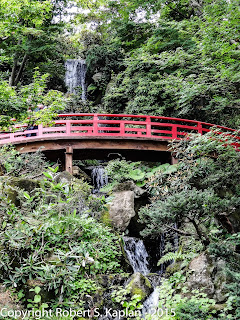Hi, The second cruise of our trip took us mostly to Honshu Island with a one day visit to Busan in Korea. The first port of this cruise was Nagasaki.
Our first stop was the Atomic Bomb Museum.
We had an opportunity to meet a survivor of the Atomic Bomb attack. He related his experience including where the various members of his family were on the morning and how the next day he and his brother went looking for his father whose place of employment was about 150 meters from ground zero. All they found were his ashes in the shape of a human being.
The museum had numerous photos and this model of the bomb.
There were two stops during the afternoon. First up was the Dejima, the recreation of the small Dutch trading post that was the sole access point between Japan and the west during Japan's long period of semi-isolation from the rest of the world.
Here is a street view of the complex.
This a closeup of the buckets on the left in the street view.
There were some actors in Japanese period costume (above and below).
Here are some interior views from houses I went into (above and 3 below).
This sculpture is a tribute to six men who contributed to exchanges between Japan and Portugal.
There is a beautiful model of the village as it appeared when it was in use (above and below).
The second stop was the Glover Garden, a park built for Thomas Blake Glover, a Scottish merchant who contributed to the modernization of Japan in shipbuilding, coal mining, and other fields. In it stands the Glover Residence, the oldest Western style house surviving in Japan.
The garden is located on a hillside. In order to walk down through the garden we took the inclined elevator in the tube shown in the photo above.
Here is another view of the elevator, on the left, a covered viewing area, and a part of the city of Nagasaki.
A small flower shop was located just outside the entrance to the bottom of the elevator.
As we walked toward the garden we passed a number of typical residences.
The Japanese love Koi. This pond was located at the top of the park.
This western style building was constructed March 1883 as a residence for Justices of the Nagasaki Court of Appeals. An invaluable example of government architecture influenced by Western styles during the Meiji period, the building was dismantled and reconstructed on the present site in 1979.
Ponds in Japanese gardens frequently have statues in them.
Thomas Glovers house has been preserved in the garden.
Here are two interior views (above and below).
The Japanese do interesting things with trees.
Once we left the garden we walked down a very steep hill
lined with a number of shops (above and below). Above is a display of cups outside one of them while below is a sign for another.
Thanks for looking.
Our first stop was the Atomic Bomb Museum.
We had an opportunity to meet a survivor of the Atomic Bomb attack. He related his experience including where the various members of his family were on the morning and how the next day he and his brother went looking for his father whose place of employment was about 150 meters from ground zero. All they found were his ashes in the shape of a human being.
The museum had numerous photos and this model of the bomb.
There were two stops during the afternoon. First up was the Dejima, the recreation of the small Dutch trading post that was the sole access point between Japan and the west during Japan's long period of semi-isolation from the rest of the world.
Here is a street view of the complex.
This a closeup of the buckets on the left in the street view.
There were some actors in Japanese period costume (above and below).
Here are some interior views from houses I went into (above and 3 below).
This sculpture is a tribute to six men who contributed to exchanges between Japan and Portugal.
There is a beautiful model of the village as it appeared when it was in use (above and below).
The second stop was the Glover Garden, a park built for Thomas Blake Glover, a Scottish merchant who contributed to the modernization of Japan in shipbuilding, coal mining, and other fields. In it stands the Glover Residence, the oldest Western style house surviving in Japan.
The garden is located on a hillside. In order to walk down through the garden we took the inclined elevator in the tube shown in the photo above.
Here is another view of the elevator, on the left, a covered viewing area, and a part of the city of Nagasaki.
A small flower shop was located just outside the entrance to the bottom of the elevator.
As we walked toward the garden we passed a number of typical residences.
The Japanese love Koi. This pond was located at the top of the park.
This western style building was constructed March 1883 as a residence for Justices of the Nagasaki Court of Appeals. An invaluable example of government architecture influenced by Western styles during the Meiji period, the building was dismantled and reconstructed on the present site in 1979.
Ponds in Japanese gardens frequently have statues in them.
Thomas Glovers house has been preserved in the garden.
Here are two interior views (above and below).
The Japanese do interesting things with trees.
Once we left the garden we walked down a very steep hill
lined with a number of shops (above and below). Above is a display of cups outside one of them while below is a sign for another.
Thanks for looking.
































































